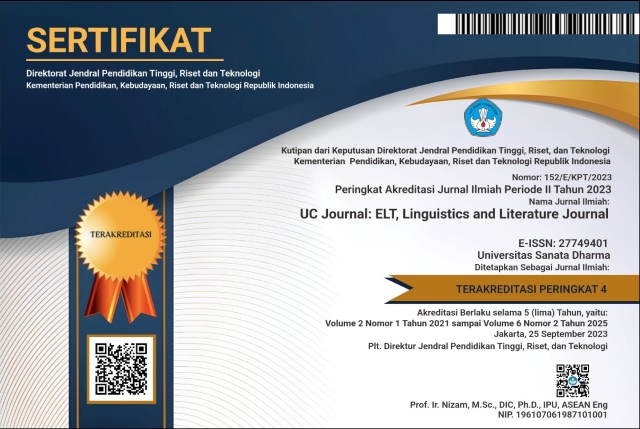METAPHORS IN BRING ME THE HORIZONS SELECTED SONG LYRICS
(1) Independent Contributor, Yogyakarta
(*) Corresponding Author
Abstract
Keywords
Full Text:
PDFReferences
Abidarda, M. (2010). A connotative meaning analysis on the word child in five lyrics of songs. Jakarta: A Thesis. English Letters Department, Adab and Humanity Faculty, State Islamic University. Retrieved on September 20, 2017, from http://repository.uinjkt.ac.id.
Arp, T. R. & Johnson, G. (2009). Perrines literature: Structure, sound, and sense (10th ed.). Boston: Wadsworth Cengage Learning.
Auerbach, E. (1957). Mimesis: The representation of reality in western literature. Garden City, New York: Doubleday & Company.
Birenbaum, H. (1997). The happy critic: A serious but no solemn guide to thinking and writing about literature. Thousand Oaks, CA: Mayfield.
Guerin, L., W., Labor, E., Morgan, L., Reesman, J., E., & Willingham, J., R. (2011). A handbook of critical approaches to literature. New York: Oxford.
Kennedy, X. J. & Gioia, D. (1999). Literature: An introduction to fiction, poetry, and drama (7th ed.). Los Angeles: Longman.
Knobloch, S. & Zillmann, D. (2002). Mood management via the digital jukebox. Journal of Communication, 2(52). Retrieved on October 17, 2017, from http://onlinelibrary.wiley.com/doi/10.1111/jcom.2002.52.issue-2/issuetoc.
Lakoff. G. & Johnson, M. (1980). Metaphors we live by. Chicago: University of Chicago Press.
Listiani, H. (2015). An analysis of figurative language found on the song lyric by Taylor Swifts Speak Now album. Salatiga: A Graduating Paper. Teacher Training and Education Faculty. English and Education Department. State Institute for Islamic Studies (IAIN). Retrieved on October 5, 2017, from perpus.iainsalatiga.ac.id.
Low, G. & Cameron, L. (1999). Researching and applying metaphor. Cambridge: Cambridge University Press.
Mooij, J. J. A. (1976). A study of metaphor: On the nature on metaphorical expressions with special reference to their reference. Amsterdam: North-Holland.
Myers, J. & Simms, M. (1989). The Longman dictionary of poetic terms. New York: Longman.
Parera, J. D. (2004). Teori semantik (2nd ed.). Jakarta: Erlangga.
Ratna, N. K. (2007). Estetika sastra dan budaya. Yogyakarta: Pustaka Pelajar.
Rettob, M. G. (2015). The metaphor analysis of selected Eminems rap songs. Yogyakarta: Teacher Training and Education Faculty, Department of Language and Arts Education, English Language Study Program, Sanata Dharma University. Retrieved on April 6, 2016 from library.usd.ac.id.
Rohrberger, M. & Woods, S. H. (1971). Reading and writing about literature. Mt. Pleasant, SC: Random House.
Silverman, K. (1983). The subject of semiotics. New York: Oxford
Szatmary, D. P. (1991). Rockin in time: A social history of rock-and-roll (2nd ed.). Englewood Cliffs, NJ: Prentice-Hall.
Trzcinski, J. (1994). Today music: Poetry or pornography? London: Routledge.
Tyson, L. (2011). Using critical theory: How to read and write about literature. Abingdon: Routledge
Waluyo, H. J. (1987). Teori dan apresiasi puisi. Jakarta: Erlangga.
Wilden, A. (1987). The rules are no game: The strategy of communication. London: Routledge.
DOI: https://doi.org/10.24071/uc.v1i1.2847
Refbacks
- There are currently no refbacks.
Copyright (c) 2020 Laurentius Jalu Waskitho Jati

This work is licensed under a Creative Commons Attribution-ShareAlike 4.0 International License.
UC Journal is indexed in:
UC Journal Sinta 4 Certificate (S4 = Level 4)
We would like to inform you that UC Journal: ELT, Linguistics and Literature Journal, or UC Journal has been nationally accredited Sinta 4 by the Ministry of Education, Culture, Research and Technology of the Republic of Indonesia based on the decree No. Surat Keputusan 152/E/KPT/2023. Validity for 5 years: Vol 2 No 1, 2021 till Vol 6 No 2, 2025
DOI: https://doi.org/10.24071/uc
e-ISSN (validity starting Vol 1, No 2, November 2020): 2774-9401

This work is licensed under CC BY-SA.
Creative Commons Attribution-ShareAlike 4.0 International License
 UC Journal: ELT, Linguistics and Literature Journal, a scientific peer-reviewed journal, was established in 20 May 2020 and is published twice a year, namely in May and November, by the English Language Education Study Programme (S1/Sarjana PBI) in collaboration with the English Education Master's Programme (S2/Magister PBI) of Sanata Dharma University, Yogyakarta, Indonesia.
UC Journal: ELT, Linguistics and Literature Journal, a scientific peer-reviewed journal, was established in 20 May 2020 and is published twice a year, namely in May and November, by the English Language Education Study Programme (S1/Sarjana PBI) in collaboration with the English Education Master's Programme (S2/Magister PBI) of Sanata Dharma University, Yogyakarta, Indonesia.














